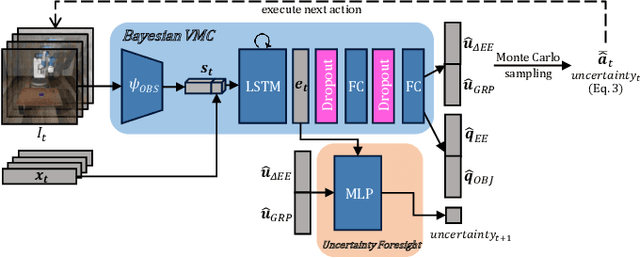Chia-Man Hung
Leveraging Scene Embeddings for Gradient-Based Motion Planning in Latent Space
Mar 06, 2023Abstract:Motion planning framed as optimisation in structured latent spaces has recently emerged as competitive with traditional methods in terms of planning success while significantly outperforming them in terms of computational speed. However, the real-world applicability of recent work in this domain remains limited by the need to express obstacle information directly in state-space, involving simple geometric primitives. In this work we address this challenge by leveraging learned scene embeddings together with a generative model of the robot manipulator to drive the optimisation process. In addition, we introduce an approach for efficient collision checking which directly regularises the optimisation undertaken for planning. Using simulated as well as real-world experiments, we demonstrate that our approach, AMP-LS, is able to successfully plan in novel, complex scenes while outperforming traditional planning baselines in terms of computation speed by an order of magnitude. We show that the resulting system is fast enough to enable closed-loop planning in real-world dynamic scenes.
* Project website: https://amp-ls.github.io/
Introspective Visuomotor Control: Exploiting Uncertainty in Deep Visuomotor Control for Failure Recovery
Mar 22, 2021



Abstract:End-to-end visuomotor control is emerging as a compelling solution for robot manipulation tasks. However, imitation learning-based visuomotor control approaches tend to suffer from a common limitation, lacking the ability to recover from an out-of-distribution state caused by compounding errors. In this paper, instead of using tactile feedback or explicitly detecting the failure through vision, we investigate using the uncertainty of a policy neural network. We propose a novel uncertainty-based approach to detect and recover from failure cases. Our hypothesis is that policy uncertainties can implicitly indicate the potential failures in the visuomotor control task and that robot states with minimum uncertainty are more likely to lead to task success. To recover from high uncertainty cases, the robot monitors its uncertainty along a trajectory and explores possible actions in the state-action space to bring itself to a more certain state. Our experiments verify this hypothesis and show a significant improvement on task success rate: 12% in pushing, 15% in pick-and-reach and 22% in pick-and-place.
Goal-Conditioned End-to-End Visuomotor Control for Versatile Skill Primitives
Mar 19, 2020



Abstract:Visuomotor control (VMC) is an effective means of achieving basic manipulation tasks such as pushing or pick-and-place from raw images. Conditioning VMC on desired goal states is a promising way of achieving versatile skill primitives. However, common conditioning schemes either rely on task-specific fine tuning (e.g. using meta-learning) or on sampling approaches using a forward model of scene dynamics i.e. model-predictive control, leaving deployability and planning horizon severely limited. In this paper we propose a conditioning scheme which avoids these pitfalls by learning the controller and its conditioning in an end-to-end manner. Our model predicts complex action sequences based directly on a dynamic image representation of the robot motion and the distance to a given target observation. In contrast to related works, this enables our approach to efficiently perform complex pushing and pick-and-place tasks from raw image observations without predefined control primitives. We report significant improvements in task success over a representative model-predictive controller and also demonstrate our model's generalisation capabilities in challenging, unseen tasks handling unfamiliar objects.
The StarCraft Multi-Agent Challenge
Feb 26, 2019



Abstract:In the last few years, deep multi-agent reinforcement learning (RL) has become a highly active area of research. A particularly challenging class of problems in this area is partially observable, cooperative, multi-agent learning, in which teams of agents must learn to coordinate their behaviour while conditioning only on their private observations. This is an attractive research area since such problems are relevant to a large number of real-world systems and are also more amenable to evaluation than general-sum problems. Standardised environments such as the ALE and MuJoCo have allowed single-agent RL to move beyond toy domains, such as grid worlds. However, there is no comparable benchmark for cooperative multi-agent RL. As a result, most papers in this field use one-off toy problems, making it difficult to measure real progress. In this paper, we propose the StarCraft Multi-Agent Challenge (SMAC) as a benchmark problem to fill this gap. SMAC is based on the popular real-time strategy game StarCraft II and focuses on micromanagement challenges where each unit is controlled by an independent agent that must act based on local observations. We offer a diverse set of challenge maps and recommendations for best practices in benchmarking and evaluations. We also open-source a deep multi-agent RL learning framework including state-of-the-art algorithms. We believe that SMAC can provide a standard benchmark environment for years to come. Videos of our best agents for several SMAC scenarios are available at: https://youtu.be/VZ7zmQ_obZ0.
 Add to Chrome
Add to Chrome Add to Firefox
Add to Firefox Add to Edge
Add to Edge